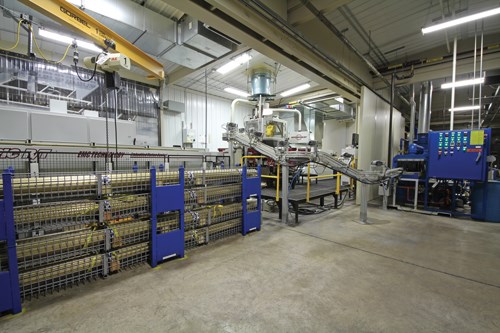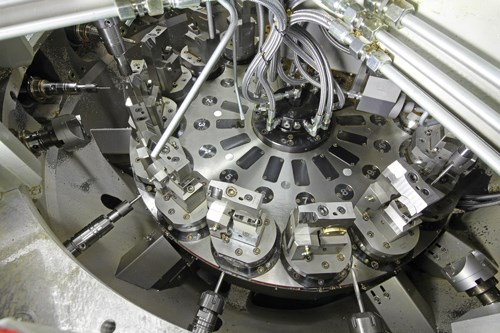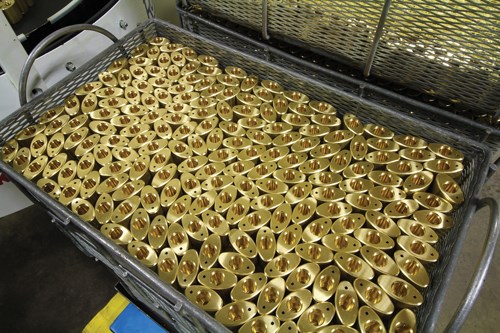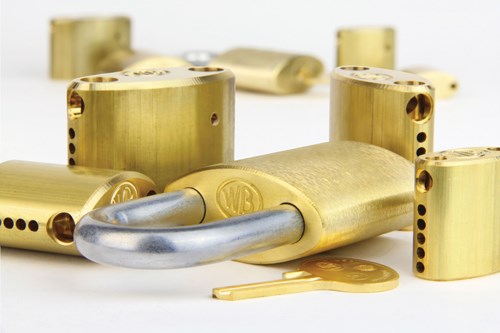An American Success Story
For 155 years, Wilson Bohannan has manufactured padlocks. It survives by innovation and continuous technological investments.
Like many American entrepreneur success stories, this one also began in a garage. The year was 1860, and this particular garage belonged to a man named Wilson Bohannan. After working in several manufacturing facilities, Mr. Bohannan was struck by the entrepreneurial spirit, so he decided to start his own padlock company with his 14-year-old son, Wilson Todd Bohannan, in the garage behind their Brooklyn, New York, home. After being granted their first patent on April 17, 1860, they were on their way.
It took 10 hard years in that garage to establish themselves, but the business was growing, and they finally moved into a larger Brooklyn facility in 1870. The business got even larger and more profitable, and in a few years they were able to install new steam powered machining equipment, this being the beginning of what would become a century and a half of automation for the Wilson Bohannan Lock Company.
In 1888, there was a boom in business from the railroad companies because of the fact that the company’s locks are all brass and don’t rust. The company was growing, and by the turn of the century, it was pumping out 100,000 padlocks a year with 200 employees. In 1927, third generation Wilson Bohannan Tway decided that a change of location was needed, so he moved the company to Marion, Ohio, a town he was impressed with during travels earlier in his life, where the company remains today.
Now let’s fast forward to Marion, Ohio, in 2015. The company is still innovating and adding machining automation.
A Family Tradition Continues
Today, Howard Smith runs the 155-year-old, family-owned, high-quality lock making venture. A 42-year veteran of the padlock wars, Mr. Smith has led the company as president since 1995. He is the sixth generation to do so.
In 1973, while studying law, he was offered a job in the accounting department at the company. Later, he continued his education while working and received his MBA from Ashland University. He married Wilson Bohannan’s great, great granddaughter, Pam.
Today, their two daughters, the seventh generation, have key roles in the company. Patricia manages the HR department, and Sarah serves by running sales and marketing. Both of their husbands also work for Wilson Bohannan, one running the manufacturing department, and the other has a position in the sales department. This is truly a family run business, and it appears it will be that way for some time to come.
Keeping it in America
For 20 years now, since Mr. Smith became president, he has been busy bringing all of the manufacturing processes in-house, and adding the newest technologies to the lock-making business. “We want flexibility today. We want to minimize inventory, increase lead time and deliver to the customer as quickly as possible. We compete with products made all over the world, and how do we do that? With hi-tech machines as we have inside this factory,” Mr. Smith says.
He is a believer in the manufacturing capability of the United States and is proud to make a product that he can say is the best and is “Made in America.” Like many successful manufacturers, there is a key individual who helps the business leader achieve his vision for a modern, automated manufacturing facility.
Thirty-eight years ago, an 18-year-old named Mark Williams got his start in the shipping department at Wilson Bohannan. Over the years, he continued to work his way up through the ranks finding a home in the engineering department. Mr. Williams showed a natural ability for the work and was eventually promoted to vice president of engineering where he has served for many years.
Mr. Williams has a keen eye for new automation ideas and has brought many of these innovations to the company’s production processes. He also is involved in product design, as well as machine design for some of the equipment in the lock assembly department.
Looking for a Better Way
When Mr. Smith and Mr. Williams started looking for a better way to create a higher volume of lock bodies, parts within a large family of products, they looked at a number of solutions. They knew about Hydromat by going to tradeshows, such as IMTS, where they always viewed the rotary transfer machines with great interest.
“We knew about Hydromat before, but that was 20 years ago, and they had not developed the CNC capabilities to the point that they have now,” Mr. Williams explains. “So, when we started to look for another transfer-type machine, we looked at Hydromat again and decided that its new CNC machine was far superior to anything we looked at before. We decided to go with the Hydromat machine from a productivity and flexibility standpoint.”
Mr. Williams was looking for a solution to produce a large variety of lock bodies in one automated cell to replace a number of machines, secondary operations and hand transportation between processes.
“We make about 25 different padlock bodies. When we originally sat down to figure out how many machining stations we needed for what we needed the machine to do, it was a very difficult and time consuming process, but with help from the application engineers at Hydromat, it went fairly smoothly. It took a while to come up with the right design. It’s everything we expected,” Mr. Williams explains. “We estimate that the Hydromat machine will be paid off in about 4 years with the production we do now, and with increased production and a decrease in labor.”
Mr. Williams wanted a machine that would be able to achieve anything he needed to manufacture in the future. What he ended up with was an exceptional, one of a kind, EPIC R/T HS-16 indexing chuck machine.
The machine has 16 horizontal machining stations and two vertical stations for a total of 18 machining stations. Each station is equipped with a three-axis CNC flange. The flexibility factor entails 67 axes on one machine, the most ever engineered into a single Hydromat. An additional six-axis Fanuc Robot rounds out the machine’s material handling process.
Turn-Key Automation Increases Flexibility and Reduces Cost
Previously, barstock was placed on tables and hand fed into a manually operated saw that cut lock body blanks to length. The blanks were put in baskets and rolled to a transfer machine where the operator hand loaded the chuck, and then manually unloaded parts back into baskets. The parts were then rolled to a wash station, then back into baskets to go to the assembly area. It was a lengthy and labor intensive process.
With the investment in the unique rotary transfer machine, Mr. Smith and Mr. Williams decided to further reduce the labor cost in producing the products by having the Hydromat engineers integrate a bundle bar feeder as well as configure a robot and a conveyor system to automatically feed and unload the parts into an aqueous wash system. “Basically, there’s no operator at the machine, it pretty much runs itself. The lock bodies run through a parts washer at the end, a worker picks up the parts and puts them in a basket,” Mr. Williams says. “Hydromat assisted us in laying it all out and worked with a company to build the conveyor system to make sure we got the proper conveyor for our application. So it is a complete turnkey operation.”
The flexibility of this machine is enhanced by the vertical chuck-style rotary transfer machine. The custom chucks were specifically designed to grip a variety of lock body sizes, so changes to the chucks are rare.
Currently, there are 25 different components in the part family; most are handled with the standard chuck setup with a chuck top-section change needed only with the smallest of lock bodies. The indexing chuck design allows Wilson Bohannan to reach five sides of the part, required for complete machining in only one chucking, improving accuracy and efficiency.
After the barstock is fed into the chuck and cut off at station 1, the part then moves through a gauntlet of cutting stations. During this process the part is face milled and chamfered on both ends, drilled and reamed numerous times on five sides by horizontal and vertical tool spindles, all with the part rotating in the indexing chucks along the way.
After 16 stations, a robot picks the part from the chuck and places it on a custom designed conveyor for the trip to the aqueous washer. After the aqueous wash, the parts are escorted to the assembly area. This happens about every 20 minutes or so. This is the extent of human interaction with the cell during most of the two daily shifts that runs the process from 5 a.m. to midnight.
Machining speed and done-in-one production are not the only efficiencies that help with labor costs. “Change-over time is greatly reduced by having full CNC,” Mr. Williams says. “We can change a machine in a matter of 2 or 3 hours. On some of our other machines, change-over could be as long as 2 days.”
Profitability Comes from Productivity
According to Mr. Smith, his manufacturing cell has been extremely profitable, saving a lot of labor costs and adding the ability to machine a large number and variety of parts on one machine and automate their post processing. “We are always looking for innovation, so products like Hydromat offer us the flexibility to not only make quick change-overs, but make a variety of products quickly,” Mr. Smith says. “It also allows us to make locking devices other than just padlocks on that machine.”
He goes on to explain that the company offers as many as 170 shackle combinations with brass or stainless steel parts for devices such as interchangeable core locks, key-in-knob cylinders, double ball locks, bolt locks, and more and more parts are being made on the cell, calling that ability “very powerful.”
Since the original patent, Wilson Bohannan locks have been known for flawless operation after many years in rough treatment. The brass material is the key. The high quality brass used in these locks are naturally rustproof and non-corrosive and possesses a natural lubricity, which allows for the locks to be used in harsh environments and withstand very cold and very hot environments.
It’s a Partnership
Today, competitive manufacturing cannot exist as the old paradigm of one man, one machine. The parts are too complex and the costs too high. Vendors must have the value-added capability of automation design, project management, training and service.
Mr. Smith has found that working with Hydromat on this current project and others meets these criteria. The Wilson Bohannan team was made aware of the service provided by Hydromat.
“Six years ago, we purchased a Tornos multi-spindle (our first multi-spindle) from the company for making some components in our padlocks,” Mr. Williams says. “Like the new cell, we received support, for training and application work that made the installation productive almost from day 1. Without backup from capable vendors, there is little incentive try new things. Thanks to a lot of help from our friends, we move forward rather than standing still.”
Yes, Wilson Bohannan is competitive worldwide, but for this family-owned and family-run business, it’s really about a 155-year-old American success story that’s still “Made in America,” right here in Marion, Ohio.
Related Content
High-Production Multitasking Becoming More Flexible
Rotary transfer machines remain well-suited for high-volume production, but are now more accommodating to smaller batch sizes.
Read MoreCNC Rotary Transfer Machine Offers AI-Learning, Chipbreaking
Hydromat’s Force CNC Rotary Transfer Machine comes equipped with Force 50/150 tool spindle units, which are FANUC-controlled and offer advanced technology for AI-learning and chipbreaking functions.
Read MoreRotary Transfer Technology Becoming More Flexible
This rotary transfer machine platform, which enables shops to reconfigure equipment to change over to new jobs as needed, is said to be effective for batch sizes of only 50 parts.
Read MoreEdge Technologies Bar Feeder Provides Optimal Stock Support
The FMB Turbo RS 4-45 bar feeder provides reduced vibration, a boost to maximum rpm, better surface finishes and the ability to hold tighter tolerances.
Read MoreRead Next
5 Aspects of PMTS I Appreciate
The three-day edition of the 2025 Precision Machining Technology Show kicks off at the start of April. I’ll be there, and here are some reasons why.
Read MoreDo You Have Single Points of Failure?
Plans need to be in place before a catastrophic event occurs.
Read MoreA Tooling Workshop Worth a Visit
Marubeni Citizen-Cincom’s tooling and accessory workshop offers a chance to learn more about ancillary devices that can boost machining efficiency and capability.
Read More


















.jpg;maxWidth=300;quality=90)







